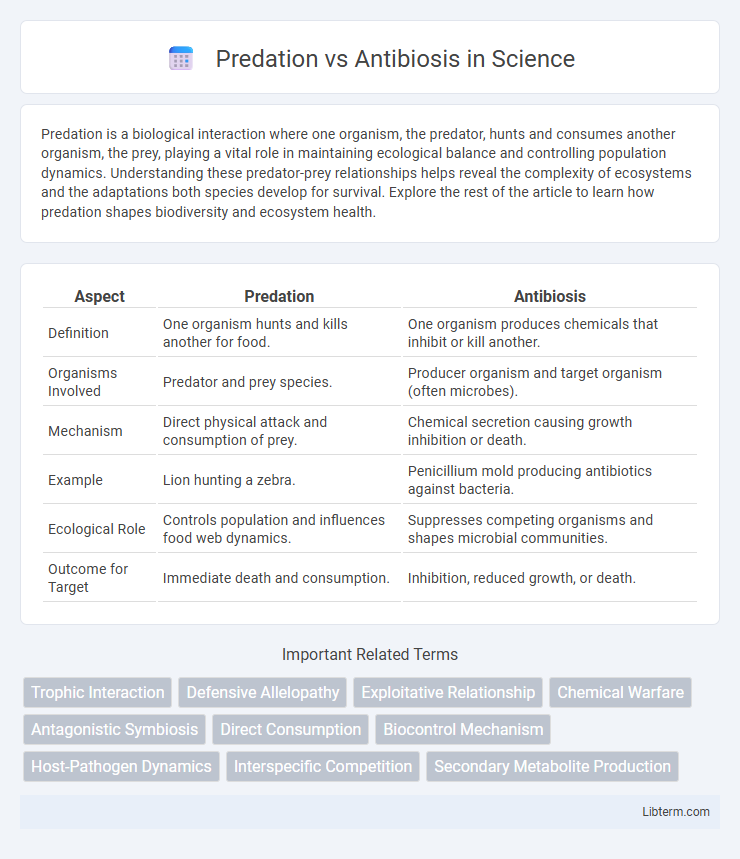Predation is a biological interaction where one organism, the predator, hunts and consumes another organism, the prey, playing a vital role in maintaining ecological balance and controlling population dynamics. Understanding these predator-prey relationships helps reveal the complexity of ecosystems and the adaptations both species develop for survival. Explore the rest of the article to learn how predation shapes biodiversity and ecosystem health.
Table of Comparison
| Aspect | Predation | Antibiosis |
|---|---|---|
| Definition | One organism hunts and kills another for food. | One organism produces chemicals that inhibit or kill another. |
| Organisms Involved | Predator and prey species. | Producer organism and target organism (often microbes). |
| Mechanism | Direct physical attack and consumption of prey. | Chemical secretion causing growth inhibition or death. |
| Example | Lion hunting a zebra. | Penicillium mold producing antibiotics against bacteria. |
| Ecological Role | Controls population and influences food web dynamics. | Suppresses competing organisms and shapes microbial communities. |
| Outcome for Target | Immediate death and consumption. | Inhibition, reduced growth, or death. |
Introduction to Predation and Antibiosis
Predation involves one organism, the predator, actively hunting and consuming another organism, the prey, playing a crucial role in controlling population dynamics and maintaining ecological balance. Antibiosis refers to the antagonistic interaction where one organism produces biochemical substances that inhibit or kill another organism, commonly observed in microorganisms such as bacteria and fungi. Both predation and antibiosis are essential biological mechanisms influencing species interactions, biodiversity, and ecosystem health.
Defining Predation in Ecology
Predation in ecology refers to the biological interaction where one organism, the predator, hunts, captures, and consumes another organism, the prey. This interaction significantly influences population dynamics, species distribution, and community structure within ecosystems. Unlike antibiosis, which involves the production of antimicrobial substances to inhibit or kill other organisms, predation is primarily a direct feeding relationship essential for energy transfer and ecological balance.
Understanding Antibiosis Mechanisms
Antibiosis mechanisms involve the production of chemical substances by microorganisms that inhibit or kill other pathogens, playing a crucial role in natural biological control. These bioactive compounds, such as antibiotics, enzymes, and toxins, disrupt cellular processes or damage microbial cell structures, effectively reducing pathogen populations. Understanding these mechanisms enhances the development of biocontrol agents in agriculture and medicine, promoting sustainable pathogen management without relying on synthetic chemicals.
Key Differences Between Predation and Antibiosis
Predation involves one organism actively hunting and consuming another for nourishment, typically involving a predator-prey relationship, whereas antibiosis refers to the production of biochemical substances by one organism that inhibit or kill another without direct consumption. Predation is characterized by immediate physical interaction and nutrient transfer, while antibiosis relies on chemical warfare, often seen in microbes producing antibiotics to suppress competitors. These mechanisms serve distinct ecological roles, with predation regulating population dynamics through direct removal and antibiosis controlling microbial communities via chemical inhibition.
Examples of Predation in Nature
Predation in nature is exemplified by the lion hunting zebras on the African savanna and the praying mantis capturing insects for sustenance. Other notable examples include the orb-weaver spider trapping flies in its web and the carnivorous Venus flytrap ensnaring insects with its specialized leaves. These interactions highlight the dynamic predator-prey relationships essential for maintaining ecological balance.
Real-World Cases of Antibiosis
Antibiosis, a biological interaction where one organism produces substances harmful to another, plays a crucial role in real-world agricultural and medical applications, exemplified by antibiotic-producing bacteria like Streptomyces used to combat plant pathogens. This phenomenon helps control harmful microorganisms by secreting antibiotics, leading to natural pest resistance and reduced reliance on synthetic chemicals. Notable examples include the use of Bacillus subtilis in biological control against fungal diseases in crops, demonstrating antibiosis as a sustainable strategy in plant protection.
Ecological Impacts of Predation
Predation regulates prey populations, maintaining ecosystem balance and preventing overpopulation that can lead to resource depletion. By controlling species abundance, predation fosters biodiversity and influences community structure through trophic cascades. This dynamic also promotes evolutionary adaptations, enhancing resilience and stability within ecological networks.
Role of Antibiosis in Ecosystem Balance
Antibiosis plays a crucial role in ecosystem balance by inhibiting the growth of harmful microorganisms through the production of antimicrobial compounds, thereby regulating microbial populations and preventing disease outbreaks. This natural biochemical interaction supports soil health and plant growth by suppressing pathogenic bacteria and fungi, contributing to nutrient cycling and biodiversity maintenance. Unlike predation, which involves direct consumption, antibiosis relies on chemical warfare, making it a vital mechanism for maintaining microbial equilibrium and ecosystem stability.
Evolutionary Significance of Predation and Antibiosis
Predation drives evolutionary adaptations by fostering traits like camouflage, speed, and defensive mechanisms in prey, while antibiosis influences microbial communities through chemical warfare, promoting the evolution of resistance and secondary metabolite production. These interactions create selective pressures that shape biodiversity and ecological balances, enhancing survival strategies across species. The evolutionary significance lies in how predation and antibiosis continuously record biological arms races, driving co-evolution and genetic diversification.
Conclusion: Predation vs Antibiosis—Implications for Biodiversity
Predation and antibiosis both significantly influence biodiversity by regulating population dynamics and species interactions within ecosystems. Predation maintains species diversity by controlling prey populations and preventing competitive exclusion, while antibiosis impedes microbial growth, shaping microbial community structures and promoting ecological balance. Understanding these mechanisms is essential for developing sustainable biodiversity conservation strategies and managing ecosystem health.
Predation Infographic

 libterm.com
libterm.com